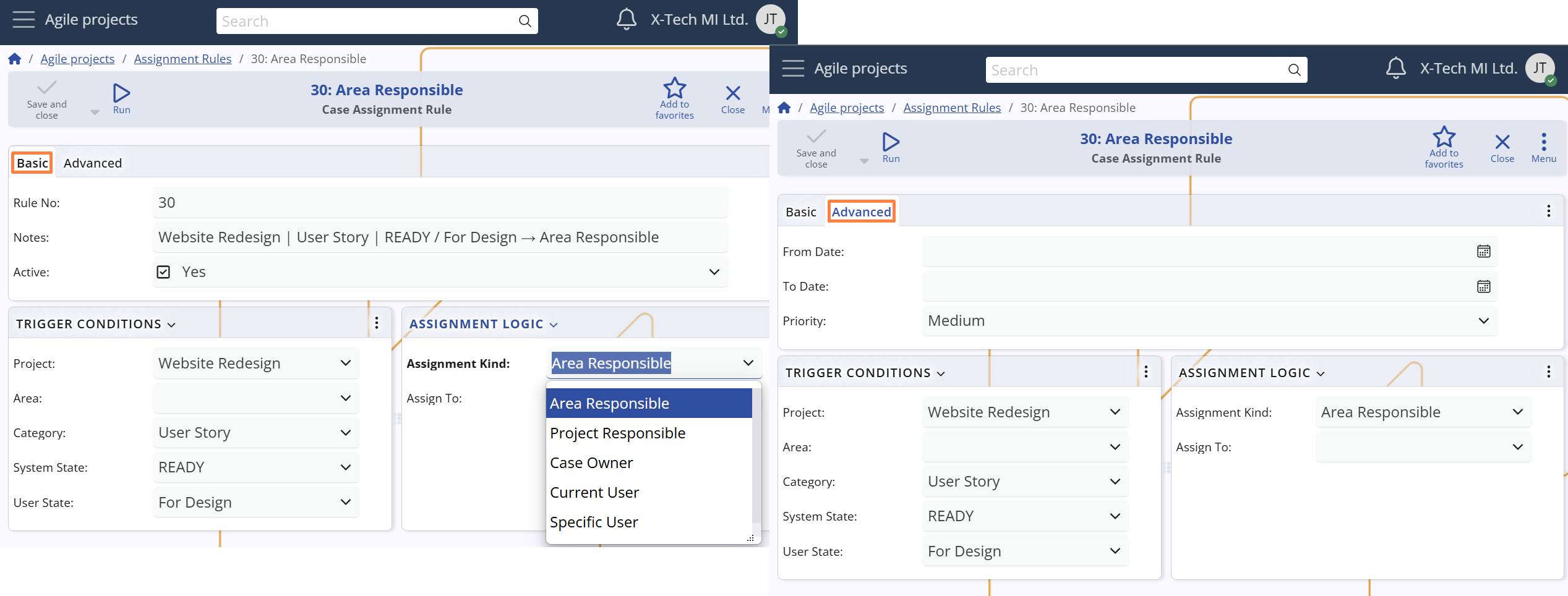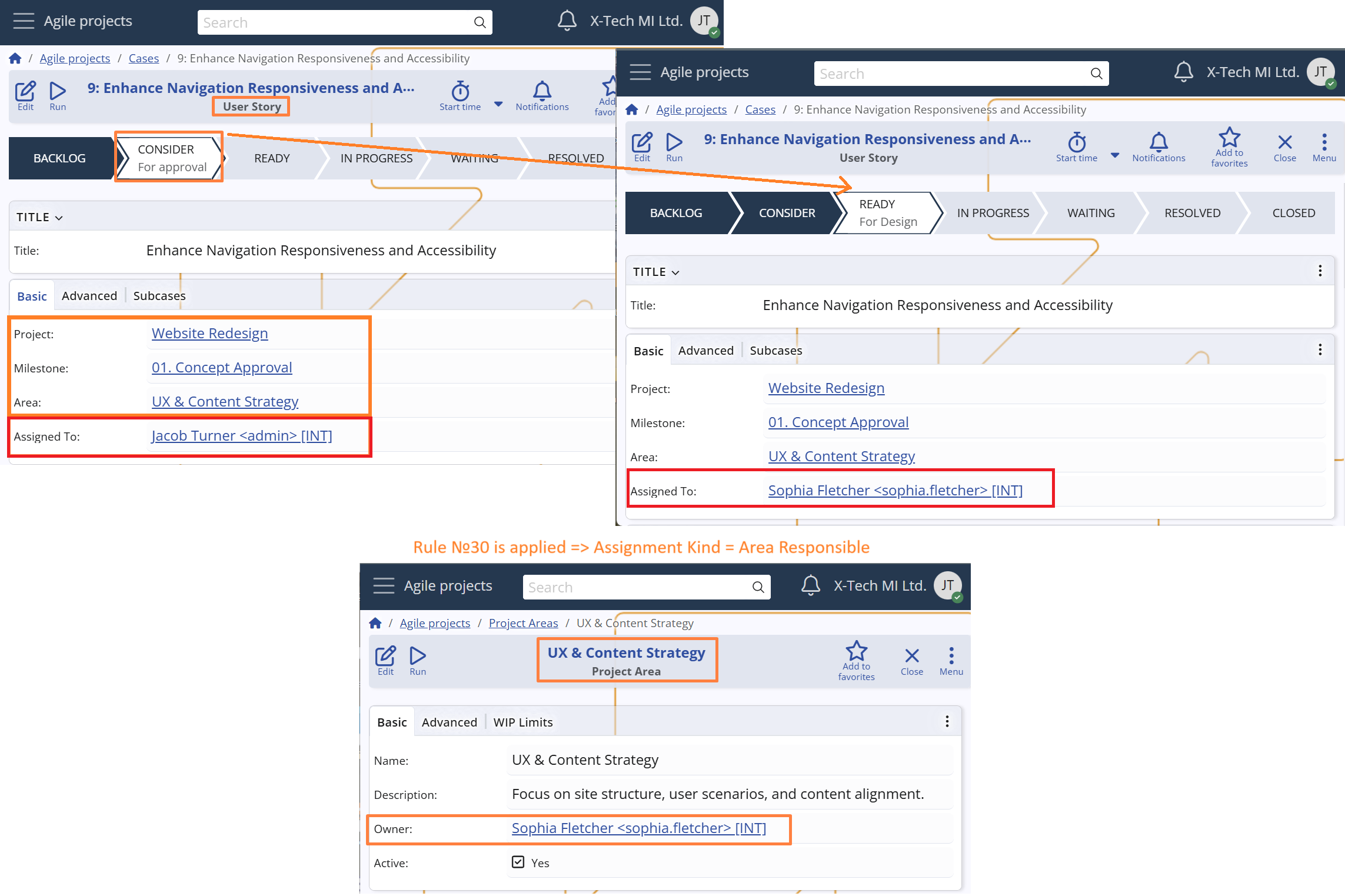Assignment rules
Case assignments in Agile PM can be managed either manually or automatically. While manual assignment is always available, organizations can streamline their workflows by defining Assignment Rules — a flexible system for automatic case routing based on predefined criteria.
Rule settings
Here are the available configuration options for each rule:
Rule availability
Each rule can be enabled or disabled and limited to a specific time period:
Active
Indicates whether the rule is currently enabled. Only active rules are evaluated by the system.From Date / To Date
Optional date range in which the rule is valid.- If empty, the rule is always valid.
- If both dates are set, the system applies the rule only within that range.
- If only one date is set, the rule is considered valid from or until that date.
Rule triggers
The rule is evaluated when one or more of the following fields from the Case match the values specified in the rule: Project, Project Area, Project Milestone, Case Category, Stakeholder Party, System State, and User State.
- If a field in the rule has a value, the corresponding value in the Case must match exactly.
- If a field in the rule is empty, it is treated as a match for any value in the Case.
The more fields you fill in, the more specific the rule becomes. Rules with empty condition fields are more general and apply to a broader range of cases.
Conflict resolution
When multiple rules match a given scenario, the system uses the following criteria to select which one to apply:
Priority
Select from: Highest, High, Medium, Low, Lowest.
Rules with higher priority take precedence.Rule No
A unique number assigned to each rule.- Used as a tie-breaker when two or more rules have the same priority.
- The rule with the higher number is used.
Tip: You can manually adjust Rule No to influence rule precedence.
Assignment logic
This setting defines who the Case will be assigned to when the rule is triggered:
Assignment Kind
Determines how the system selects the assignee. Options include:Area Responsible – assigns to the Primary User of the Project Area.
Suitable for team-based case assignment.Project Responsible – assigns to the Primary User of the Project.
Useful for centralized control or leadership assignment.Case Owner – assigns to the Owner of the Case.
Ensures that the designated responsible person receives it.Current User – assigns to the user who made the triggering change (e.g., updated the case state).
Useful for self-assignment or contextual handling.Specific User – assigns to a fixed user defined in the rule.
n this case, the Assign To User field becomes required.
This setup provides flexibility to support both static and dynamic assignment patterns, allowing the system to reflect organizational structure, business rules, and real-time actions.

Rule logic
Assignment Rules are automatically evaluated whenever a Case is updated and one or more of its Condition Fields change. This enables the system to respond dynamically to changes in the Case’s structure, categorization, or state.
The logic follows these main steps:
1. Triggering rule evaluation
When any of the following Condition Fields in the Case is changed:
- Project
- Project Area
- Project Milestone
- Case Category
- Stakeholder Party
- System State
- User State
The system begins rule evaluation based on the updated values.
2. Rule evaluation
The system evaluates all active Assignment Rules and applies the following conditions:
- The rule must be active (Active = True)
- The current date must be within the rule’s validity period (From Date and To Date)
- Each of the Condition Fields in the rule must either:
- Match the current value in the Case, or
- Be left empty, which means “applies to all”
If multiple rules match:
- The rule with the highest Priority is selected
- If multiple rules share the same priority, the rule with the highest Rule No. takes precedence.
3. Assignment execution
Once the best-matching rule is identified, the system determines the appropriate user based on the rule’s Assignment Kind (e.g., Area Responsible, Specific User, Current User).
That user is then assigned to the Case by updating its Assigned To User field.
Example
A Case is initially created with the following values:
- Project = Website Redesign
- Project Milestone = 01. Concept Approval
- Project Area = UX & Content Strategy
- Case Category = User Story
- System State = CONSIDER
- User State = For approval
- Assigned To User = Jacob Turner
- Stakeholder Party = null
The Case is then updated with:
- System State = READY
- User State = "For Design"
There are four active Assignment Rules in the system:
Rule №10
- Project = Website Redesign
- Project Area = null (applies to all)
- Project Milestone = null (applies to all)
- Case Category = null (applies to all)
- Stakeholder Party = null (applies to all)
- System State = CONSIDER
- User State = For approval
- Assignment Kind = Project Responsible //Jacob Turner
- Priority = Medium
Rule №20
- Project = Website Redesign
- Project Area = null (applies to all)
- Project Milestone = null (applies to all)
- Case Category = null (applies to all)
- Stakeholder Party = null (applies to all)
- System State = READY
- User State = For Design
- Assignment Kind = Specific User
- Assign To User = Michael Reeds
- Priority = Medium
Rule №30
- Project = Website Redesign"
- Project Area = null (applies to all)
- Project Milestone = null (applies to all)
- Case Category = User Story
- Stakeholder Party = null (applies to all)
- System State = READY
- User State = For Design
- Assignment Kind = Area Responsible //Sophie Fletcher
- Priority = Medium
Rule №40
- Project = Product Strategy
- Project Area = null (applies to all)
- Project Milestone = null (applies to all)
- Case Category = Design Issue
- Stakeholder Party = null (applies to all)
- System State = READY
- User State = For Design
- Assignment Kind = Specific User
- Assign To User = Ryan Powell
- Priority = Medium
Rules №20 and №30 both match the current Case values.
Since they have the same priority, the rule with the higher Rule No. is selected.
➤ The Case is assigned to Sophie Fletcher, the Primary User of Project Area "UX & Content Strategy".

